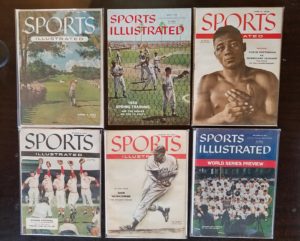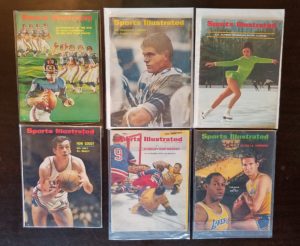Sports Illustrated/TIME Blog #31 – Unicorns, Hen’s Teeth and 9.8’s!
Welcome to my Sports Illustrated/TIME magazine blog – Your collector’s guide to the latest hobby updates and insight into what’s trending now.
What do unicorns, hen’s teeth and 9.8’s have in common? They’re all hard to find??? In previous blogs, I have touched on the recent grading trends coming out of CGC. Echoing the sentiment of graded magazine dealers across the country, the higher grades are getting more and more scarce and 9.8’s are a pretty much a thing of the past. How does that effect you, the collector and is that a good thing or a bad thing?
To my readers that follow graded magazine hobby trends – this is my most important blog to date.
First – the current CGC 9.0 is the new CGC 9.8 with regard to pre – 2000 magazines. The CGC 9.8 is pretty much a thing of the past – not impossible but very, very, very unlikely and more unlikely the older the magazine. Given the scrutiny of the today’s grading, a CGC 9.0 grade is a gem and worthy of bragging rights. Assuming no magazine is perfect (there has never been a CGC 10.0 or a CGC 9.9 since the beginning of grading at CGC) – not even right off the printing press – so as collectors we need to set our expectations accordingly. Here is a calculation for you to ponder – and please don’t ask me to substantiate. These are my calculations – believe or don’t. It is widely accepted that newsstand SI’s from the 50’s 60’s and 70’s accounted for 2% of the overall circulation. My estimate of that circulation is that 1% would be worthy of grade submission today and 1% of those would attain the grade of CGC 9.0 or higher. If the circulation was, say, 3,000,000 per week, the total issues of a week’s circulation achieving a CGC 9.0 or higher would be 3,000,000 x .02 x .01 x .01 = 6. If you chose to believe these calculations (or something similar), then you know why it’s so difficult to find these high grade magazines. What this means is that with each issue there is a potential, after all mags of that issue have been reviewed, to uncover 6 with a grade of CGC 9.0 or higher in today’s world. Therefore, anything above CGC 9.0 is worthy of the much overused term – “rare”. And rare translates to me as a market mover. If you have a pre-1980 CGC 9.0 SI issue, it very likely is a “none higher, POP 1” or within that range. And if there is a mag or two higher, that number is most likely 6 or under.
If you don’t like my assumptions, then here are some facts. This blog is the only place you will find this data and analysis. Due to the excitement surrounding the hobby and the emergence of new investors and collectors, the graded magazine hobby is in a state of constant change. For the past two years I have been recording historical grading data across 34 of what I consider to be the most relevant SI issues.
- Regarding SI submissions for CGC grading, in the 18 months between July 2016 and December 2017, there were 62 recorded CGC 9.8 grades. Rejoice if you have one of two of these.
- Regarding SI submissions for CGC grading in 2018 YTD (8 months), there were three 9.8 grades recorded – two of these were post year 2000 and the other was the #1 issue. Not one, repeat, not one, 9.8 grade was recorded on any SI submission dating between 1955 and 2000 across the balance of the 31 most relevant issue dates.
- With only one exception, since the beginning of this year, no issue date has even recorded a new highest grade. That means whatever the highest grade was 8 months ago, only one grade has improved.
This is seriously important information if you are at all interested in the future of this hobby.
Here are some inferences we might draw from the provided data.
- It is most likely that magazine issue dates pre-1980, currently with a mid to high CGC 9.4 -9.8 grade as their highest graded submission, will never be beaten. When buying or selling one of these (CGC 9.4-9.8), consider the highest graded issue now will always be the highest graded issue. Nothing is guaranteed, but if you are a statistical collector, you’ll like these odds.
- The pre-1980 CGC 9.8’s you previously purchased over the past several years are rarified. Set the buy and sell price accordingly. The same follows for any CGC 9.0 and above, perhaps just to a slightly lesser extent.
- Collectors should be taking advantage of high grade issues as they surface because high grade magazines are not like cards – significantly less have survived. The escalating values you are seeing in the big auction houses is not a fad. It is the result of supply and demand. As I have predicted and we are already witnessing, as more collectors come into the market, the supply of high grade magazines is not going to be able to keep up. There has been and will be just enough high grades to generate a growing hobby interest but not nearly enough to satisfy demand. If you own the product that is exactly what you want.
There is no substitute for knowledge. Going into any transaction as the most prepared assures you the edge and having the edge translates into equity. Project yourself out six months and look back to today. You won’t believe the pricing. Watch and see!
I hope you are enjoying the reads on the history of TIME and SI magazines as well as an insight into relevant magazine collecting.
Great collecting to you and best fortunes with Sports Illustrated/TIME!






















